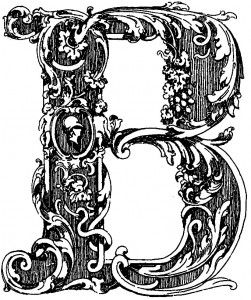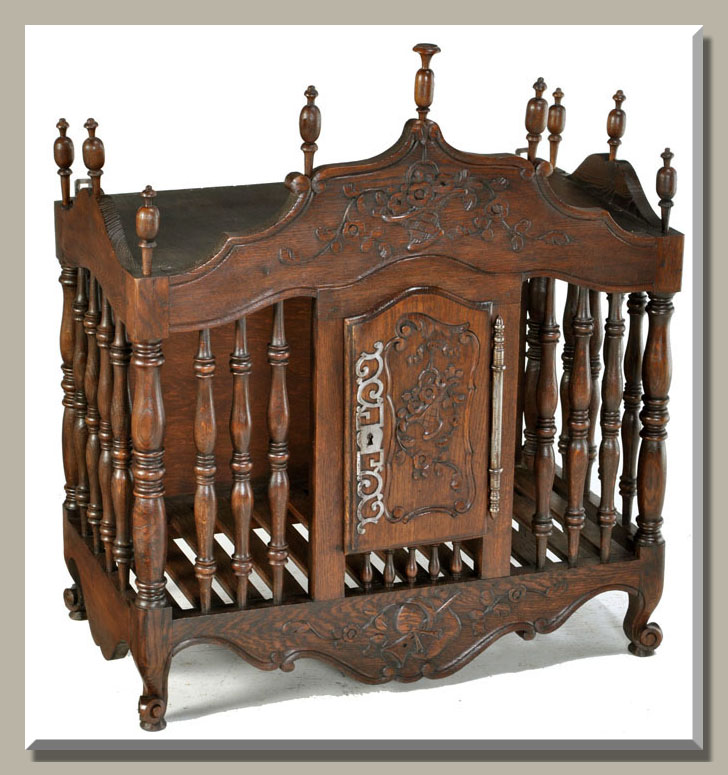 read is the staff of life, quotes an old proverb. The panetiere, or breadbox, is considered a highly collectible French antique and represents a celebrated symbol of Country French tradition~ the making of bread. Bread has been one of Europe’s staples for centuries, and over the course of time the French elevated the daily task and ritual of bread-making to an art form.
read is the staff of life, quotes an old proverb. The panetiere, or breadbox, is considered a highly collectible French antique and represents a celebrated symbol of Country French tradition~ the making of bread. Bread has been one of Europe’s staples for centuries, and over the course of time the French elevated the daily task and ritual of bread-making to an art form.
As a baker myself, I know the time it takes to mix dough, let it rise twice, and then bake a loaf or two of bread. This time-consuming process was repeated two or three times a week in French home kitchens, and developed into gastronomic delights that varied from region to region.
The panetiere evolved to provide a safe haven for the hard work of the bread makers of the family, and first appeared in its current form during the 18th century in Southern France. The panetiere ultimately saw use in kitchens all over France, but most notably in Provence until shortly after World War I.
Panetieres were usually crafted with fittings to allow them to be hung on the wall, keeping the bread safe from children and pets, until it could be served at the family table. The best and most original panetieres are those of Provence, which then influenced those of Languedoc and Dauphiné. Originally the panetiere was simply a wooden box, perforated and placed directly on the table. In the 18th century, turned wood spindles and more decorative aprons and cornices began to appear, replacing coarse wood panels. We also see at this time the addition of small doors through which the bread could be inserted, and locks to further secure the perishable treasure.
But it was the 19th century that saw this formerly ordinary kitchen appointment develop into an art form. Again, Provence led the way~ adding turned spindles to create the case, with corner posts topped in acorn-shaped finials. These finials took many other forms, and were described as candeliers, or chandelles. In the region around Avignon it was common to use fletching motifs designed to resemble bird feathers, while further south near the coast around Arles, bobeches were common adornments. Talented sculptors began to add more motifs glorifying the country life, including ears of corn, pecking birds, fruit clusters, and other motifs based on the leaves and flowers of local plants.
Antique panetieres are becoming more scarce with each passing year, and their value varies widely depending upon a number of attributes. The overall condition of course is always important, as is the state of the metal such as hinges, keyguards and locks. The type of wood may have a little effect upon the value, but is not as important as the fineness of the carved embellishment and the architecture. Those with bombe fronts are particularly valuable, especially when well-preserved. The originality of the chandelles, bobeches and feet, as well as the hardware, also play an important role in any panetiere’s value.

Hand-crafted from fine French chestnut by the talented artisans of Provence, this panetiere features a trademark of Provence~ a triple-arched crown adorned with hand-carved embellishment and topped with turned chandelles, the centermost taking a plume shape, and all of which are original to the piece. Hand forged hardware includes the original lock, hinge, and elaborate keyguard or ferrure. Musical instruments are carved in relief on the scalloped apron, with a flower baskets on the door and cornice. Many times such highly decorative panetieres were wedding or anniversary gifts, and the floral & musical adornments symbolized a flowering marriage with harmony in the home. The turned spindle rails surrounding the area where proud families stored their daily bread for the mid-day and evening meals kept the children or pets from sneaking a loaf. Many families kept the bread under lock and key, hung from the wall which also served to display this family heirloom for all to see and appreciate. Circa 1890s.
So as we enjoy our baguettes today from the local bakery, we can thank the bakers of the past for the invention of French bread and the artisans of France for creating a prized French antique ~ the panetiere!








love French bread and can see why the French elevated breadmaking to such an artform…what a lovely panetiere…
best,
maureen